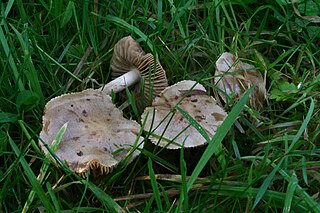
Hebeloma is a genus of fungi in the family Hymenogastraceae. Found worldwide, it contains the poison pie or fairy cakes (Hebeloma crustuliniforme) and the ghoul fungus (H. aminophilum), from Western Australia, which grows on rotting animal remains.

Hebeloma crustuliniforme, commonly known as poison pie or fairy cakes, is a gilled mushroom of the genus Hebeloma found in Europe and North America, and has been introduced into Australia. Its specific name derives from the Latin crustulum or little biscuit. It is moderately poisonous.
Hebeloma aestivale is a species of mushroom in the family Hymenogastraceae. It was originally described from Denmark. It is in the Velutipes section of the genus. H. aestivale has also been described in the United Kingdom, where it is one of the more commonly documented Hebeloma species.
Hebeloma alpinum is a species of mushroom in the family Hymenogastraceae. It was originally described from Switzerland by Favre as variety alpina of Hebeloma crustuliniforme; G. Bruchet raised it to species status in 1970.
Hebeloma ammophilum is a species of mushroom in the family Hymenogastraceae. It was described as new to science in 1978.

Hebeloma anthracophilum is a species of mushroom in the family Hymenogastraceae. It was first described as Agaricus birruss by Elias Fries in 1838.
Hebeloma arenosum is a species of mushroom in the family Hymenogastraceae. Described as new to science in 1986, it was first recorded in Wisconsin, where it was growing on sandy soil in a nursery bed containing Norway pine.
Hebeloma atrobrunneum is a species of mushroom in the family Hymenogastraceae. Described as new to science in 1989, it was found on moist soil growing under Willow plants in Denmark.
Hebeloma cylindrosporum is a species of mushroom-forming fungus in the family Hymenogastraceae. It was described as new to science in 1965 by French mycologist Henri Romagnesi.

Hebeloma gigaspermum is a European species of mushroom in the family Hymenogastraceae.
Hebeloma dunense is a species of agaric fungus in the family Hymenogastraceae.
Hebeloma sinuosum is a species of agaric fungus in the family Hymenogastraceae. First described as Agaricus sinuosus by Elias Magnus Fries in 1838, it was later transferred to Hebeloma by Lucien Quélet in 1893.

Hebeloma sinapizans, commonly known as the rough-stalked Hebeloma or the bitter poisonpie, is a species of mushroom in the family Hymenogastraceae. It has a strong radish-like smell, and a prominent bulbous stem base. It is larger than the similar and more common H. crustuliniforme, a relative that is also poisonous. H. sinapizans is found in Europe and North America.

Hebeloma radicosum, commonly known as the rooting poison pie, is a species of agaric fungus in the family Hymenogastraceae. Fruit bodies (mushrooms) can be identified by the tapering root-like stipe base, as well as the almond-like odor. Found in Japan, Europe, and North America, it is an ammonia fungus, and fruits on mole, mouse, or shrew middens.

Hebeloma pusillum is a species of mushroom in the family Hymenogastraceae. It is found in Europe.
Hebeloma vinosophyllum is a toxic species of agaric fungus in the family Hymenogastraceae. It contains eleven poisonous compounds collectively known as hebevinosides. An ammonia fungus, it tends to grow on the corpses of animals. The species was described by Japanese mycologist Tsuguo Hongo in 1965. It was recorded from Vietnamese Pinus kesiya forests in 2014, its first record in Southeast Asia.
Hebeloma vaccinum is a species of agaric fungus in the family Hymenogastraceae. It was described as new to science in 1965 by French mycologist Henri Romagnesi.
Ammonia fungi are fungi that develop fruit bodies exclusively or relatively abundantly on soil that has had ammonia or other nitrogen-containing materials added. The nitrogen materials react as bases by themselves, or after decomposition. The addition of ammonia or urea causes numerous chemical and biological changes, for examples, the pH of soil litter is increased to 8–10; the high alkaline conditions interrupts the process of nutrient recycling. The mechanisms of colonization, establishment, and occurrence of fruiting bodies of ammonia fungi has been researched in the field and the laboratory.
John Alan (Jack) Elix emeritus professor in chemistry at the Australian National University, is an organic chemist who has contributed in many fields: lichenology, lichen chemotaxonomy, plant physiology and biodiversity and natural product chemistry. He has authored 2282 species names, and 67 genera in the field of mycology.







